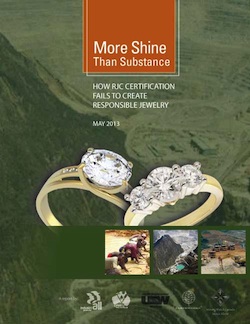From the executive summary:
In 2005, in the wake of campaigns targeting dirty gold and conflict diamonds, and media exposés of the high environmental and social costs of these minerals, jewelry companies and trade associations recognized that their brands and reputations were at risk. These jewelry retailers and manufacturers joined forces with a few mining companies and metals refiners to establish a multi-sector trade association, the Responsible Jewellery Council, or RJC. In 2009, the RJC launched its certification system in order to “increase consumer confidence in diamond, gold and platinum group metals jewellery …through the successful implementation of a system for certification of responsible business practices that is widely recognized and valued by our stakeholders.”
In the years since, RJC has steadily grown its membership, reaching 440 members to date. This report examines the scope of RJC’s certification system, and analyzes its components: its governance, membership, standards, auditing, and system for dealing with complaints, among others. It concludes that the RJC system and its components are riddled with flaws and loopholes on each of these fronts, rendering it an ineffective tool by which to create an environmentally and socially responsible supply chain in the jewelry industry. As currently structured, RJC’s certification cannot provide consumers with meaningful reassurance about the ethical antecedents of the jewelry and minerals produced by its member companies. Without significant improvements, the system risks tarnishing, rather than burnishing, the reputations of its member companies.


